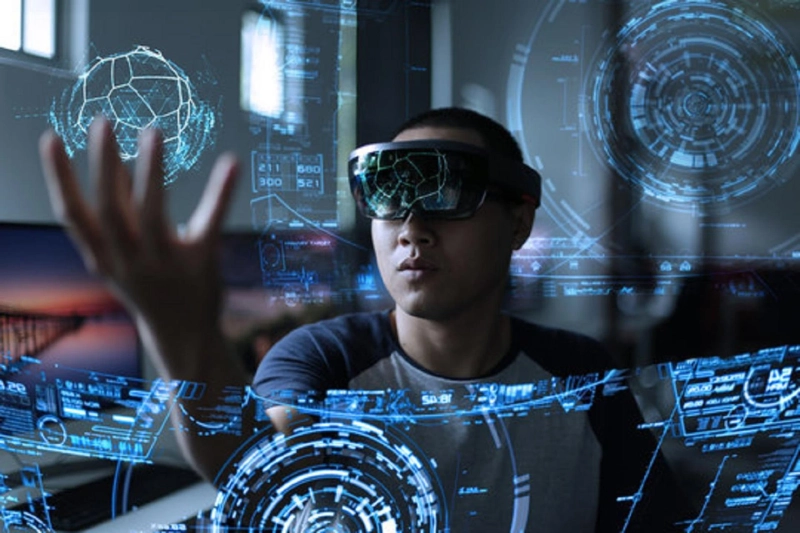Augmented Reality (AR) has come a long way from being a niche technology limited to gaming and experimental applications. In 2025, AR is no longer just an innovative gimmick—it’s a powerful tool that’s transforming industries from retail and education to healthcare, real estate, and beyond. As AR continues to evolve, so do the ways in which it integrates with our daily lives, offering new possibilities for interaction, immersion, and intelligence.
In this blog, we explore the latest trends in AR that are driving its growth and reshaping the way we see and interact with the world.
1. AR and AI: A Smarter Synergy
One of the most significant trends in AR this year is its integration with Artificial Intelligence (AI). By combining AR’s visual overlay capabilities with AI’s data processing and decision-making powers, developers are creating intelligent AR experiences that adapt in real time.
Example applications:
- Smart Shopping Assistants: AI-powered AR apps can scan a product and instantly display price comparisons, user reviews, and sustainability ratings.
- AI-Driven AR Tutors: In education, AR tutors use AI to recognise a student’s progress and adjust content accordingly.
- Object Recognition and Scene Understanding: With AI, AR applications can now better understand their surroundings and tailor overlays with greater accuracy.
This fusion is making AR more responsive, contextual, and personalised, key to mass adoption.
2. WebAR: AR Without the App
WebAR, or browser-based AR, has gained major traction in 2025. One of the major barriers to AR adoption used to be the need to download dedicated apps. WebAR eliminates that friction by allowing users to access AR experiences directly through mobile browsers—no downloads, no waiting.
Why it's big in 2025:
- WebAR campaigns are easier to share via social media, QR codes, or links.
- Marketers and retailers use WebAR for virtual try-ons, interactive ads, and branded AR experiences with better reach and lower costs.
- Supported by frameworks like 8thWall, ZapWorks, and WebXR, WebAR is becoming more powerful and visually appealing.
As mobile browsers get faster and support better 3D rendering, WebAR is fast becoming the go-to choice for AR marketing. Learn more about AR headsets here.
3. AR in Retail: Virtual Try-Ons and Spatial Shopping
AR continues to revolutionise the retail landscape in 2025 with hyper-personalised shopping experiences.
Key developments:
- Advanced Virtual Try-Ons: Consumers can now virtually try on clothes, glasses, makeup, and even tattoos with realistic precision using AR filters powered by depth sensors and AI-based fitting algorithms.
- In-Store Navigation and Product Info: Physical stores are now using AR navigation tools to guide customers to specific aisles and products, while providing real-time stock levels and reviews.
- AR Mirrors and Smart Fitting Rooms: Mirrors embedded with AR tech help shoppers view different colours or styles of a product without physically trying them all.
Retailers are embracing AR to reduce returns, enhance customer engagement, and blend the physical and digital shopping journey (phygital retail).
4. AR for Remote Work and Collaboration
The post-pandemic world solidified the remote work culture, and in 2025, AR is playing a major role in making remote collaboration more natural and immersive.
Trending AR tools include:
- AR Meeting Rooms: Using AR headsets, like Realwear Navigator 520, or even smartphones, remote teams can visualise 3D models, flowcharts, and virtual workspaces in their real environments.
- Interactive Whiteboards: AR-powered whiteboards allow real-time annotations, sticky notes, and brainstorming sessions across continents.
- Remote Troubleshooting: In industries like manufacturing and IT, AR enables remote experts to guide on-site workers through complex tasks using AR annotations and live visuals.
Tech giants like Microsoft (with HoloLens), Magic Leap, and Meta are continually innovating AR collaboration tools for enterprise users.
5. AR in Healthcare: From Training to Surgery
The healthcare industry is experiencing a surge in AR adoption across multiple areas.
Current healthcare AR trends:
- Medical Training: Students use AR headsets to simulate surgeries or anatomy exploration, enhancing retention and understanding.
- Surgical Assistance: Surgeons are now using AR overlays during operations to visualise internal organs, tumours, or bones without opening the body excessively.
- Patient Education: AR apps help doctors show patients what’s happening inside their bodies, improving understanding and communication.
In 2025, AR is not just assisting physicians but also playing a role in mental health therapy, rehabilitation, and elderly care.
6. AR Glasses and Wearables Go Mainstream
While AR headsets have been around for years, 2025 is seeing a new generation of sleek, lightweight AR glasses designed for everyday use.
Big shifts include:
- Consumer AR Glasses: Meta, Apple, and Samsung have released consumer-grade AR glasses that display notifications, maps, translations, and health data without the bulk.
- Enterprise Wearables: For industries like construction and logistics, AR helmets and glasses now provide real-time instructions, hazard detection, and equipment diagnostics.
- Fashion Meets Tech: AR glasses now come in fashionable designs, aiming to be as socially acceptable as smartwatches.
As batteries get smaller and processors more efficient, wearable AR is shedding its sci-fi image and becoming truly wearable.
7. AR in Education: Interactive, Immersive Learning
Education is one of the sectors being deeply transformed by AR in 2025. From primary schools to universities, AR is bringing textbooks to life.
Popular use cases:
- 3D Science Models: Students can explore the solar system, chemical molecules, or historical landmarks in interactive 3D.
- Language Learning: AR overlays show translated words, pronunciations, and usage in real-time environments.
- Gamified Learning: AR-based educational games encourage engagement and retention, especially among younger students.
AR is making learning more fun, inclusive, and effective, especially in underfunded schools that lack physical lab equipment.
8. AR in Navigation and Tourism
AR is elevating travel and tourism experiences in ways we’ve never seen before.
What’s trending:
- AR Navigation Apps: Walking or driving directions now include virtual arrows, street labels, and live POIs layered on top of the real world.
- Cultural Storytelling: Tourists can use AR to view reconstructions of ancient ruins, historical figures, or battle scenes at heritage sites.
- Museum Enhancements: Museums are integrating AR to offer richer, multimedia content as users point their phones at exhibits.
This trend makes exploration more interactive and accessible, even for those travelling solo or without a tour guide.
9. AR in Real Estate and Architecture
Real estate and construction sectors are leveraging AR for better decision-making and client satisfaction.
2025 trends include:
- Virtual Property Staging: Agents can show unfurnished homes with different furniture and layout styles using AR apps.
- Construction Visualisation: AR helps architects and builders visualise blueprints on-site, making planning and error detection more accurate.
- Client Walkthroughs: Prospective buyers or tenants can “walk through” a future building before it’s even constructed.
The use of AR in real estate shortens sales cycles, reduces misunderstandings, and enhances client trust.
10. AR for Advertising and Branding
2025 is witnessing a boom in AR-powered advertising, also known as immersive or experiential marketing.
Innovations to watch:
- Interactive Billboards: Outdoor ads now include AR triggers that launch interactive experiences when scanned with a phone.
- Gamified Campaigns: Brands are using AR games to build engagement and encourage social sharing.
- Personalised Ads: Using geolocation and behavior data, AR ads now tailor experiences to each user.
With higher ROI and engagement rates than traditional formats, AR is becoming a must-have tool in marketers' arsenals.
11. Spatial Computing and Persistent AR
As AR tech matures, we’re entering the age of spatial computing, where AR experiences remember and react to the physical world over time.
This means:
- AR can “remember” the placement of virtual objects in your room.
- Multiple users can interact with the same virtual object from different devices.
- Environments become dynamic and layered with long-term digital content.
Think of a virtual whiteboard that stays on your wall or a digital pet that lives in your living room. These persistent experiences are laying the groundwork for the future metaverse.
12. AR and the Metaverse: A New Digital Layer
While the term "metaverse" gained massive buzz in the early 2020s, 2025 is seeing it materialize in a more practical and augmented way.
AR is now seen as the metaverse’s real-world interface, enabling:
- Overlaying metaverse objects in real life
- Creating spatially aware avatars that react to physical surroundings
- Conducting AR meetings, hangouts, and events in mixed reality
Unlike the fully virtual VR-based metaverse, AR offers a more accessible, blended experience that bridges the digital and physical realms.
Challenges Still Ahead
While AR is growing rapidly, it’s not without its challenges:
- Privacy and Data Security: AR collects visual and spatial data—raising concerns around surveillance and misuse.
- Device Costs and Accessibility: While AR glasses are improving, they are still expensive for mass adoption.
- Content Creation: AR development remains complex and time-consuming, though low-code tools are helping bridge this gap.
Solving these issues will be key to unlocking AR’s full potential.
Final Thoughts
As we move deeper into 2025, Augmented Reality is no longer just a “cool tech” on the sidelines—it’s a game-changer. From the way we shop and learn to how we socialise and work, AR is reshaping our interaction with the digital and physical world alike.
Whether you’re a developer, business owner, educator, or curious consumer, now is the time to explore the vast opportunities AR offers. With AI, WebAR, and spatial computing on the rise, the future of AR looks not only immersive, but intelligent and interconnected.
Are you ready for the augmented world?



